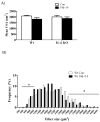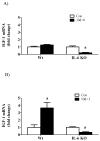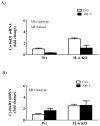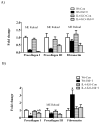Skeletal muscle mass recovery from atrophy in IL-6 knockout mice
- PMID: 21418148
- PMCID: PMC3129379
- DOI: 10.1111/j.1748-1716.2011.02281.x
Skeletal muscle mass recovery from atrophy in IL-6 knockout mice
Abstract
Aim: Skeletal muscle interleukin-6 (IL-6) expression is induced by continuous contraction, overload-induced hypertrophy and during muscle regeneration. The loss of IL-6 can alter skeletal muscle's growth and extracellular matrix remodelling response to overload-induced hypertrophy. Insulin-like growth factor-1 (IGF-1) gene expression and related signalling through Akt/mTOR is a critical regulator of muscle mass. The significance of IL-6 expression during the recovery from muscle atrophy is unclear. This study's purpose was to determine the effect of IL-6 loss on mouse gastrocnemius (GAS) muscle mass during recovery from hindlimb suspension (HS)-induced atrophy.
Methods: Female C57BL/6 [wild type (WT)] and IL-6 knockout (IL-6 KO) mice at 10 weeks of age were assigned to control, HS or HS followed by normal cage ambulation groups.
Results: GAS muscle atrophy was induced by 10 days of HS. HS induced a 20% loss of GAS mass in both WT and IL-6 KO mice. HS+7 days of recovery restored WT GAS mass to cage-control values. GAS mass from IL-6 KO mice did not return to cage-control values until HS+14 days of recovery. Both IGF-1 mRNA expression and Akt/mTOR signalling were increased in WT muscle after 1 day of recovery. In IL-6 KO muscle, IGF-1 mRNA expression was decreased and Akt/mTOR signalling was not induced after 1 day of recovery. MyoD and myogenin mRNA expression were both induced in WT muscle after 1 day of recovery, but not in IL-6 KO muscle.
Conclusion: Muscle IL-6 expression appears important for the initial growth response during the recovery from disuse.
© 2011 The Authors. Acta Physiologica © 2011 Scandinavian Physiological Society.
Conflict of interest statement
There is no conflicts of interest.
Figures













Similar articles
-
Overload-induced skeletal muscle extracellular matrix remodelling and myofibre growth in mice lacking IL-6.Acta Physiol (Oxf). 2009 Dec;197(4):321-32. doi: 10.1111/j.1748-1716.2009.02029.x. Epub 2009 Aug 3. Acta Physiol (Oxf). 2009. PMID: 19681796 Free PMC article.
-
High-Molecular-Weight Polyphenol-Rich Fraction of Black Tea Does Not Prevent Atrophy by Unloading, But Promotes Soleus Muscle Mass Recovery from Atrophy in Mice.Nutrients. 2019 Sep 6;11(9):2131. doi: 10.3390/nu11092131. Nutrients. 2019. PMID: 31500089 Free PMC article.
-
Mature IGF-I excels in promoting functional muscle recovery from disuse atrophy compared with pro-IGF-IA.J Appl Physiol (1985). 2014 Apr 1;116(7):797-806. doi: 10.1152/japplphysiol.00955.2013. Epub 2013 Dec 26. J Appl Physiol (1985). 2014. PMID: 24371018 Free PMC article.
-
Myostatin-deficient mice lose more skeletal muscle mass than wild-type controls during hindlimb suspension.Am J Physiol Endocrinol Metab. 2003 Jul;285(1):E82-7. doi: 10.1152/ajpendo.00275.2002. Epub 2003 Mar 4. Am J Physiol Endocrinol Metab. 2003. PMID: 12618358
-
PI3 kinase regulation of skeletal muscle hypertrophy and atrophy.Curr Top Microbiol Immunol. 2010;346:267-78. doi: 10.1007/82_2010_78. Curr Top Microbiol Immunol. 2010. PMID: 20593312 Review.
Cited by
-
Effect of irradiation on Akt signaling in atrophying skeletal muscle.J Appl Physiol (1985). 2016 Oct 1;121(4):917-924. doi: 10.1152/japplphysiol.00218.2016. Epub 2016 Aug 25. J Appl Physiol (1985). 2016. PMID: 27562841 Free PMC article.
-
Interleukin-6 is dispensable in pituitary normal development and homeostasis but needed for pituitary stem cell activation following local injury.Front Endocrinol (Lausanne). 2022 Dec 22;13:1092063. doi: 10.3389/fendo.2022.1092063. eCollection 2022. Front Endocrinol (Lausanne). 2022. PMID: 36619565 Free PMC article.
-
Graft alignment impacts the regenerative response of skeletal muscle after volumetric muscle loss in a rat model.Acta Biomater. 2020 Mar 15;105:191-202. doi: 10.1016/j.actbio.2020.01.024. Epub 2020 Jan 22. Acta Biomater. 2020. PMID: 31978621 Free PMC article.
-
Skeletal Muscle Depletion Predicts the Prognosis of Patients with Advanced Pancreatic Cancer Undergoing Palliative Chemotherapy, Independent of Body Mass Index.PLoS One. 2015 Oct 5;10(10):e0139749. doi: 10.1371/journal.pone.0139749. eCollection 2015. PLoS One. 2015. PMID: 26437072 Free PMC article.
-
The Impact of Immune Cells on the Skeletal Muscle Microenvironment During Cancer Cachexia.Front Physiol. 2020 Aug 31;11:1037. doi: 10.3389/fphys.2020.01037. eCollection 2020. Front Physiol. 2020. PMID: 32982782 Free PMC article. Review.
References
-
- Adams GR. Role of insulin-like growth factor-I in the regulation of skeletal muscle adaptation to increased loading. Exerc Sport Sci Rev. 1998;26:31–60. - PubMed
-
- Adams GR. Autocrine and/or paracrine insulin-like growth factor-I activity in skeletal muscle. Clin Orthop Relat Res. 2002:S188–96. - PubMed
-
- Adams GR, Haddad F. The relationships among IGF-1, DNA content, and protein accumulation during skeletal muscle hypertrophy. J Appl Physiol. 1996;81:2509–16. - PubMed
-
- Adams GR, Haddad F, Baldwin KM. Time course of changes in markers of myogenesis in overloaded rat skeletal muscles. J Appl Physiol. 1999;87:1705–12. - PubMed
-
- Ahtikoski AM, Koskinen SO, Virtanen P, Kovanen V, Takala TE. Regulation of synthesis of fibrillar collagens in rat skeletal muscle during immobilization in shortened and lengthened positions. Acta Physiol Scand. 2001;172:131–40. - PubMed
Publication types
MeSH terms
Substances
Grants and funding
LinkOut - more resources
Full Text Sources
Research Materials
Miscellaneous

